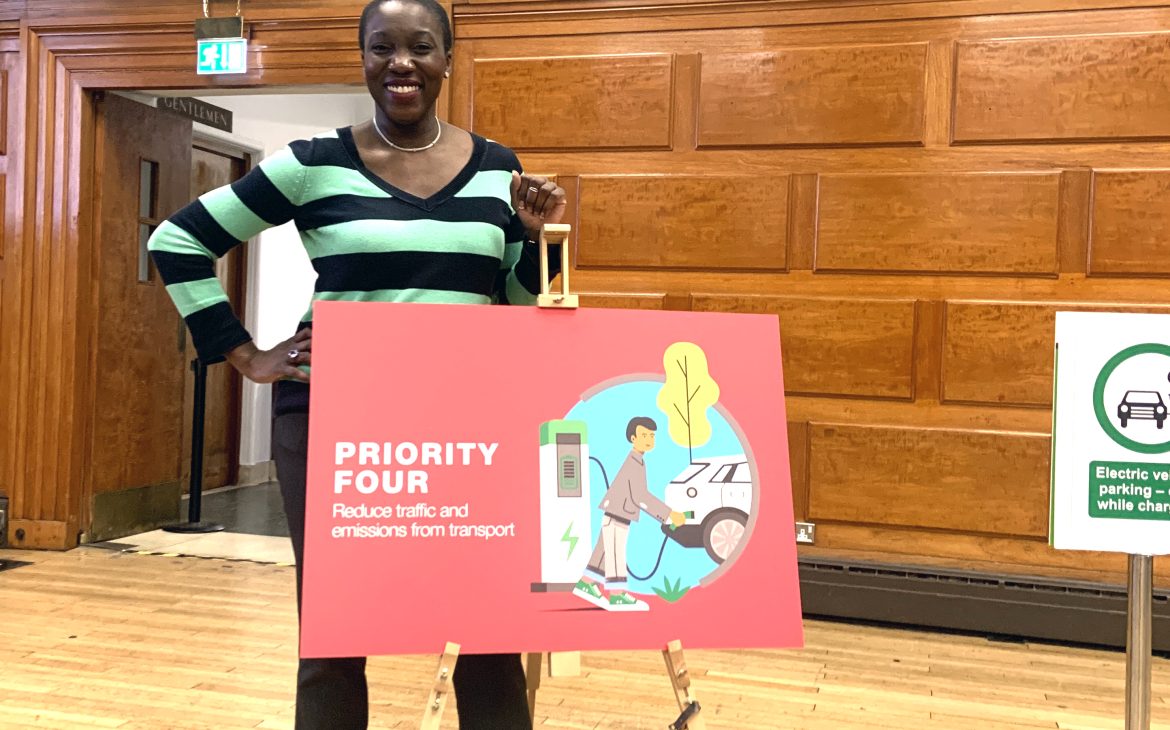
On 31 January, 2023 I was invited to take part in the launch of the Lambeth’s Kerbside Strategy at Lambeth Town Hall. The Kerbside Strategy is comprised of four priorities which are designed to improve the overall environment – socially and environmentally:
Priority 1 – enable accessible and active travel
Priority 2 – create social spaces
Priority 3 – increase climate resilience
Priority 4 – reduce traffic and emissions
The launch started with a word from Cllr Rezina Chowdhury, before different panellists provided context for the importance of the four priorities. Dr Nedah Darabi reflected on the importance of not only safer, but more accessible roads (Priority 1). Ethan Brinkworth of local coffee shop Perks and White spoke about the positive impact that access to e-cargo bikes had on his business and the wider community (Priority 1). Dennis Boateng of InUse ReUse shared his experience of the potential for parklets to foster a greater sense of community (Priority 2). Hammant Bharadia of The Courtesan on Atlantic Road talked about the potential impact parklets could have for local businesses (Priority 2). Francis Bernstein of Friends of Gipsy Hill spoke about the risks of climate change he has witnessed and importance of bolstering climate resilience (Priority 3).
Here is an excerpt of what I shared regarding Priority 4:
‘Poor air quality is a funny concept. We are told that it is really, really bad for our health but we can’t see it. When the headlines read that food prices are going up, our pockets feel the pinch. Or if someone says it’s cold outside, we confirm this when we step out and our cheeks feel pinched. But when someone says that air quality is poor, how do we respond to this? If you are anything like me when something is out of sight, it’s out of mind.
I spent the bulk of my time looking into EV adoption in London – in particular whether or not ethnicity was a factor in EV adoption in London. As we know, a widespread shift to EVs can go some way to improving air quality.
The motivation for my study was actually my daughter. My eldest child is allergic to peanuts, pistachios and cashews. She’s not unique, there are a growing number of children who have to carry epi pens with them for allergies to a bunch of foods that I, and I’m sure many of you, enjoyed in abundance as a children Her allergies didn’t sit right with me as our family doesn’t have a history of allergies. So when I found a paper that discovered a link between poor air quality and food allergies and that was all I needed to get started with my studies.
As part of my overall research, I looked for a relationship between housing type per London borough and EV registrations per London borough and found that boroughs that had higher percentages of terraced housing had lower percentages of EV registrations. This is key because ethnic minorities in England are more likely to live in flats and terraced housing.
Although poor air quality can’t be seen or touched, it is responsible for an estimated 4,000 deaths in London and has been linked to a host of other public health concerns. In 2018, air pollution in London reached the legal limit for the whole year less than a month into the year and those figures were recorded in Lambeth.
Personally, I think that what makes poor air quality particularly tricky is not just that we can’t see or touch it, but that it’s also very difficult to personally and individually address it. When food prices go up, we can make adjustments to the way we buy food. And when the mercury dips we can change how we use energy or layer up before heading out (or staying in). But how do we individually address the air we breathe??? That said, just because it’s difficult to address at an individual level, doesn’t mean that it shouldn’t be addressed at all.
Priority 4 of Lambeth’s Kerbside Strategy is to reduce traffic and emissions from transport. To be clear this isn’t simply about moving everyone from one type of vehicle to another type of vehicle. It’s about giving residents opportunities to take an even more integrated approach to the way we travel by removing barriers and levelling the playing or the kerbside access as it were.

It means that more cycling racks can be installed, encouraging more of us to cycle from point A to point B. And for those who still require the use of a vehicle, dedicating more of the kerbside to installation of charging points means that you should feel more confident to switch to an EV.
What’s interesting about the overall Kerbside strategy is not only the priorities work together to make Lambeth a better place overall but that the strategy is informed by the voices, insights and opinions of the people who regularly use the local roads.’
